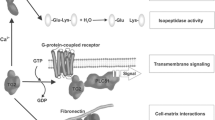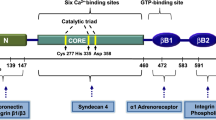Summary.
Celiac disease (CD) is an autoimmune pathology of the small intestine triggered, in genetically predisposed patients, by the exposition to gliadin, a flour protein, thus evoking local immune reactions and mucosal atrophy. The discovery that type 2 transglutaminase (TG2) is the main, if not the sole, target of the endomysium CD-specific autoantibodies assigned to this enzyme a master regulator role of CD. Two separated events, both based on the finding that gliadin is able to act as a TG2 substrate, have been described to indicate that TG2 is involved in both the humoral and cellular immune responses. In this paper we review the novel insights on the localization and enzymatic activity of TG2 in the small intestinal mucosa. Moreover, we report on the capability of gliadin and its peptides to act as TG2 substrates.
Similar content being viewed by others
Author information
Authors and Affiliations
Rights and permissions
About this article
Cite this article
Caputo, I., D’Amato, A., Troncone, R. et al. Transglutaminase 2 in celiac disease: Minireview article. Amino Acids 26, 381–386 (2004). https://doi.org/10.1007/s00726-004-0083-7
Received:
Accepted:
Published:
Issue Date:
DOI: https://doi.org/10.1007/s00726-004-0083-7




